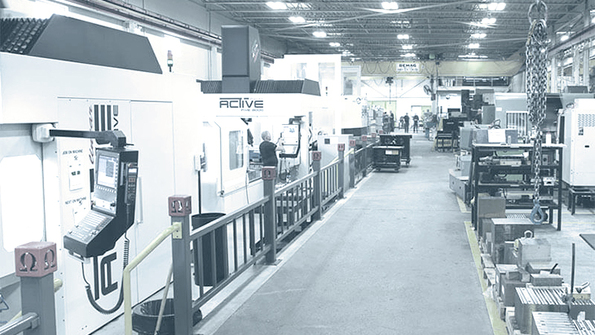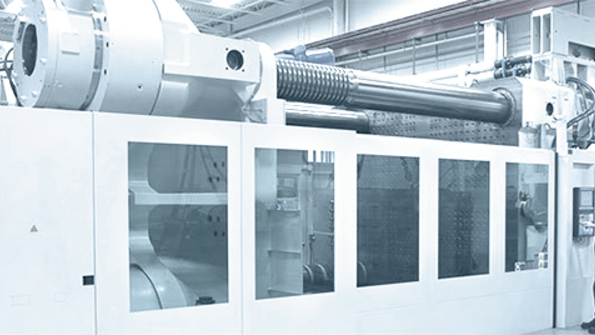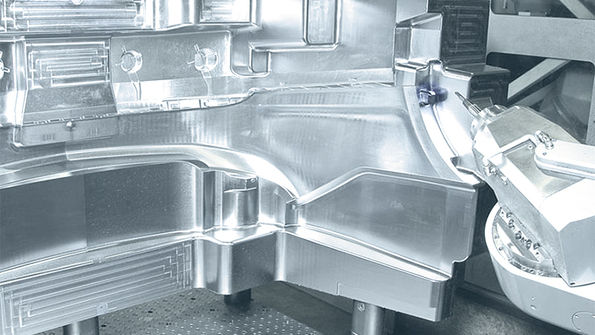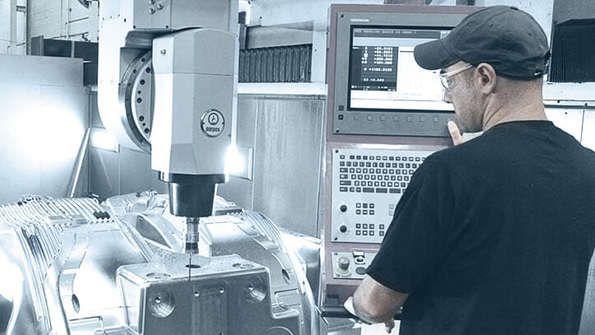No turning back
For this innovative mold maker, a combination of advanced equipment, strategic thinking, and Tebis software has expanded their definition of what is possible, and there is no end in sight.
Company
Omega Tool Corporation
Location
Oldcastle, Canada
Focus
Consulting/Simulation
Sector
Mold manufacturing
Published
2015

Interviewee: Delko Prebeg, Martin Chaput, COO, Resource Utilization Manager
Tebis has helped us achieve excellent and very predictable surface finishes; plus, it’s not difficult to learn and use – our people seem to pick up on it pretty quick.

For Omega Tool Corp., an Oldcastle, Ontario, Canada-based tool mold maker, good isn’t enough. That’s true for Chief Operating Officer Delko Prebeg, as well as Omega’s highly skilled and motivated workforce. That stems, in part, from the fact that the company has fostered, and profited from, a culture of continuous improvement and innovation that has been recognized by their peers and customers in the form of an award from the Professional Engineers of Ontario, among other examples. It’s also due to the fact that Omega centers its focus on servicing and selling to industry leading customers that expect and deserve flawless execution.
“Our niche is molds for medium to large, complex, aesthetic automotive parts,” says Prebeg, “Competition in the auto industry has always been fierce; with the 2008 recession it reached a whole new level.”
It was around this time that manufacturing industry consulting firm Harbour Results, Inc. (Southfield, MI) issued a report on the tool, die and mold industry. “We determined that OEM’s spend $10 billion per year on tools,” recounts Harbour consultant Nick Stanziola. “That caught Ford’s eye and they saw an opportunity to consolidate their tooling spending with fewer suppliers like they had done with their production suppliers.”
Toward this end, Harbour was asked to qualify key tool, die and mold shops that were manufacturing products for Ford. This was done via a standardized two-day assessment eventually involving 180 different facilities around the globe, including Omega. Scoring was on a 0 to 100 “flexibility” scale, and shops with a score of less than 55 were intended to be “filtered off” the vendor list. There were also other, more subjective yardsticks relative to overall fit with Ford, technology, global footprint, continuous improvement, company culture and other factors called the Y-axis score. The interplay between these two scores gave Ford more flexibility in its evaluations. For instance, a high flexibility score but a low Y-axis might mark a facility as an overflow shop, while a lower flexibility score but a high Y-axis might prompt Ford to take a closer look at the facility and consider ways it could help the shop improve.
Component machining bay at Omega Old Castle, Ontario facility.Component machining bay at Omega Old Castle, Ontario facility.
“Harbour facilitated development of a refreshed, strategic and focused five year plan that would encompass the company’s pre-determined goals and objectives,” says Stanziola. The company had begun its renewal during the 2008 recession with plans to execute on a number of objectives immediately thereafter. Some of the objectives of Omega management included upgrading plant-floor equipment, minimizing the outsourcing of machining, improving machine throughput, and establishing standards and driving those standards to the plant floor.
Other plans already in process included establishment of a validation facility as well as starting a second production facility in Mexico. Harbour’s facilitation and consulting expertise provided for the successful renewal and revival of a long-term strategic plan that was created by and through the resourceful engagement of Omega’s management and team members. It’s been a fruitful partnership, Harbour and Omega, one that continues to this day, but Omega was about to get a new ally in its drive to add value and enhance its competitiveness: CAD/CAM supplier Tebis America, Inc. (Troy, MI.).

Omega had already been successfully using Tebis software and in 2013 the relationship between the two companies expanded and deepened. That’s when Omega called in a team of Tebis consultants from Germany to provide an analysis of Omega’s processes and benchmark them against their global peer group. These Tebis manufacturing experts assisted with recommendations in the areas of process, standardization, increased machine utilization and output. They wanted to explore ways in which an expanded use of Tebis software, and the Tebis approach to manufacturing, could help Omega achieve the competitiveness goals outlined in their five year plan. They liked what they heard.
The simulation advantage
“We weren’t using simulation at all until we started using the Tebis simulation system in 2013,” says Sal Mazza, Facilities Resource Manager, “It’s had a tremendous impact on our operations.”
Tebis simulation allows users to optimize machine operations by enabling them to identify and avoid possible collisions between component and tool geometry, check tool lengths before NC program calculation, and interactively define the optimum tilt direction. In addition, the system’s material removal simulation lets users realistically assess surface qualities.
These tools are particularly useful when Omega employs full 5-axis simultaneous milling. Before they calculate an NC program they can perform a detailed analysis of the tilt directions for the tool, also taking head geometry and machine kinematics into account. Collision avoidance calculations include the holder components defined in the Tebis tool library, and the Tebis simulator checks all machine components and limit switches.
“This not only lets us optimize machining, but it saves on programming time as well,” says Martin Chaput, Resource Utilization Manager.
“Using the Tebis simulator has resulted in huge savings,” he continues. “That’s because it allows us to maximize the utilization of our equipment and increase initial throughput.” He cites, for example, the fact that Omega can now run jobs on their smaller machines which had formerly been reserved for larger machines with more costly run-times in order to be sure to avoid reaching a machine limit. Now, with a precise knowledge of tool and fixture dimensions and how various components dynamically interact with a machining program, those fears are gone.

“Additional downstream effects include improved accuracy, less rework, and a reduction in spotting and fitting time because of the heightened accuracy,” he notes. “It has helped us achieve excellent, and very predictable, surface finishes; plus, it’s not difficult to learn and use -- our people seem to pick up on it pretty quick.”
“In addition,” adds Vernon Benson, Account Manager for Tebis, “Omega uses the simulation to help them program offline and do it efficiently -- another time saver. This is compounded by the fact that they can run programs through simulation in order to check the run times. This helps improve scheduling and thus machine utilization, which is an increasingly important part of their strategic five year plan.”
Benson notes that some of Omega’s competitors use simulation, but typically they will use a third party, transferring data into and out of their CAD/CAM system. This slows programming and increases the opportunities for error. But for Omega this doesn’t happen, since simulation is fully integrated with the Tebis suite of software tools, as well as with its information rich approach to manufacturing.
Banking on information and data
Information and data is golden in today’s manufacturing environment, and to glean more of it Omega introduced an in-process measuring procedure capable of measuring defined features as well as free-form measurement on their shop floor and machining centers. Here, too, the growing partnership with Tebis is paying off.
“When they introduced their in-process measuring procedure, we interfaced it with our Measuring Point Generator (MPoint) surface measurement module for measurement, together with our Surface Measurement module for advanced analysis. This enables Omega to check for variance between the workpiece and the CAD geometry and make needed corrections in real time,” said Benson.
Omega operator at inspection process machining verification system.Omega operator at inspection process machining verification system.
Increasingly, those workpieces are the product of complex, 5-axis milling programs. “We are continually moving into 5-axis milling, along with more 3+2 axis milling,” says Prebeg. There was a limitation as far as software providers who could help us make the best use of these machines, but Tebis has come through here.”
Some CAM software packages struggle with large 5-axis parts because these parts generally entail a large amount of data, and large amounts of data will slow down the software. With Tebis, though, the algorithms plus the design of the software, enable it to handle massive amounts of data very quickly. Also, many other 5-axis CAM solutions the machine’s movement can be choppy. With Tebis these movements can be done very smoothly, leading to exceptional surface finishes, a vital consideration for a mold builder like Omega.
In addition, Omega now does a lot of “head work,” or 3+2 axis tip angle work. “In machining large parts, Benson explains, “it is often necessary to tip the machine head in order to adjust the machining angle. Any time you have to change the angle or vector of the tool you are adding a lot of complexity which, again, can slow down your software, but Tebis can handle this.

“Ours isn’t the only system that can handle 3+2 axis tip angle work,” he admits, “but we bring something new to the party. You can click on the machine head or the tool and simulate its operation, make adjustments on the fly if need be, and then send this amended or edited program back to the machine.”
In keeping with its vision of data as a key indicator of the strategic performance enhancements that Omega is committed to, they instituted a resource (machine utilization) tracking system. Here, too, Tebis is playing a role, having interfaced its system to the resource dashboard, so that shopfloor personnel can access relevant CAD/CAM data.
“The system tracks machine efficiency and availability,” says Prebeg, “which translates into better machine utilization, and that is central to our plans for moving forward.
“Typically, companies usually run less than desirable capacities,” he continues. “After working with Tebis, as well as the other initiatives we’ve undertaken, we are running at over 90% utilization rates.” With the aid of the Tebis Multiple Setup module and new technology in the form of shuttles and material handling robots, Prebeg is confident that figure will largely improve.
This has been accompanied by a 10% reduction in total machining time required on any give job compared to the prior year, while overall productivity has increased by about 30% in the last two years.
Machine throughput has thus been drastically improved, and the other goals of the five year plan have been largely attained, or on track to be attained as well. For example, a significant portion of outsourced machining has been brought back in-house due to the company’s continued focus on throughput and the accuracy of the machine programs generated with Tebis software. As Chaput puts it, “Tebis cuts exactly, there are no wasted cuts.”
Engineering standardization has also proceeded, with all programming done in the same Tebis template style. Additionally, Omega is working with Tebis to optimize cutter paths and reduce air cutting, a more common occurrence than most tool shops realize or would care to admit. There has been a host of other improvements as well, but the key point was perhaps summarized by Tebis’ Benson when he observed, simply, “They’re pushing the envelope of what they can do.”
And they don’t plan on stopping. As Delko Prebeg observes, “We’re committed to our lean principles and continuous improvement -- that’s just who we are and what we do.”


